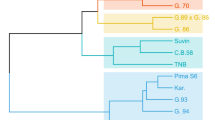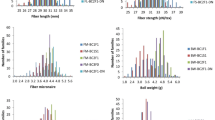Abstract
A broad range of cotton (Gossypium hirsutum L.) germplasm resources exist with characteristics useful for improving modern cotton cultivars. However, much of this germplasm is not well utilized. The objective of this study was to evaluate agronomic and fiber traits of four germplasm populations to determine the effectiveness of pooling germplasm for generating variability to improve traits of interest. Four populations were developed with parents chosen based on (1) dwarfing genes, (2) a combination of fiber strength and length traits, (3) glandless genes, or (4) inclusion in the G. hirsutum center-of-origin, i.e. race, germplasm group. The dwarf germplasm population had smaller bolls, a smaller lint index, a smaller seed index, lower micronaire, and shorter fibers than the other three populations. There were no significant differences in lint yield, elongation, or strength among the germplasm populations. In contrast to the general lack of significant differences among populations for agronomic and fiber traits, within population variation was observed to be high. Therefore, selections could be made within the race population to raise lint yields and within the fiber population to increase fiber length. Likewise, selections within the glandless population could be made for boll size, lint index, seed index, micronaire, and strength. These results suggest that intercrossing multiple parents in complex populations generates a large amount of variability with potential uses in crop improvement.
Similar content being viewed by others
References
Anonymous (1981) Preservation and utilization of germplasm in cotton. Southern Cooperative Series Bulletin, No. 256
Bowman DT, May OL, Calhoun DS (1996) Genetic base of Upland cotton cultivars released between 1970 and 1990. Crop Sci 36:577–581
Brubaker CL, Bourland FM, Wendel JF (1999) The origin and domestication of cotton. In: Smith CW, Cothren JT (eds) Cotton: origin, history, technology, and production. Wiley, New York, pp 1–31
Fehr WR (1991) Principles of cultivar development.Volume 1: Theory and technique. Macmillian Publishing Company, New York
Jones JE (1982) The present state of the art and science of cotton breeding for leaf-morphological types. In: Proceedings of the Beltwide cotton production research conference, Las Vegas, NV; 3–7 Jan 1982; Natl Cotton Counc Am, Memphis, TN, pp 93–99
Kohel RJ, Richmond TR, Lewis CF (1970) Texas Marker-1: description of a genetic standard for Gossypium hirsutum L. Crop Sci 10:670–671
Kramer CY (1956) Extension of multiple range tests to group means with unequal numbers of replications. Biometrics 12:309–310
Kuk MS, Tetlow R (2005) Gossypol removal by adsorption from cottonseed miscella. J Am Oil Chem Soc 82:905–909
Liu S, Cantrell RG, McCarty JC Jr, McD Stewart J (2000) Simple sequence repeat-based assessment of genetic diversity in cotton race stock accessions. Crop Sci 40:1459–1469
McCarty JC, Wu J, Jenkins JN (2007) Use of primitive derived cotton accessions for agronomic and fiber traits improvement: variance components and genetic effects. Crop Sci 47:100–110
McMichael SC (1959) Hopi cotton, a source of cottonseed free of gossypol pigments. Agron J 51:630
McMichael SC (1960) Combined effects of the glandless genes gl2 and gl3 on pigment glands in the cotton plant. Agron J 46:385–386
Nichols SP, Snipes CE, Jones MA (2004) Cotton growth, lint yield, and fiber quality as affected by row spacing and cultivar. J Cotton Sci 8:1–12
Percival AE, Wendel JF, Stewart JM (1999) Taxonomy and germplasm resources. In: Smith CW, Cothren JT (eds) Cotton: origin, history, technology, and production. Wiley, New York, pp 33–64
Quisenberry JE (1975) Inheritance of plant height in cotton. I. A cross between Lubbock Dwarf and Texas Marker-1. Crop Sci 15:197–199
Royston P (1992) Approximating the Shapiro-Wilk W-test for non-normality. Statist Comput 2:117–119
Simmonds NW (1993) Introgression and incorporation: strategies for the use of crop genetic resources. Bio Rev Camb Phil Soc 68:539–562
Smith FH, Clawson AJ (1970) The effects of dietary gossypol on animals. J Am Oil Chem Soc 47:443–447
Smith CW, Hague S, Hequet E, Thaxton PS, Brown IN (2008) Development of extra-long staple upland cotton. Crop Sci 48:1823–1831
Smith CW, Braden CA, Hequet EF (2010) Genetic analysis of fiber length uniformity in upland cotton. Crop Sci 50:567–573
Van Esbroeck G, Bowman DT (1998) Cotton germplasm diversity and its importance to cultivar development. J Cotton Sci 2:121–129
Woodward WTW, Malm NR (1976) Influence of lint percentage on yield, boll, and fiber characteristics in acala strains of upland cotton. Crop Sci 16:594–596
Zeng L, Meredith WR Jr (2009) Associations among lint yield, yield components, and fiber properties in an introgressed population of cotton. Crop Sci 49:1647–1654
Acknowledgments
The authors gratefully acknowledge S. Wang, J. Harris, B. Cervantez, and K. Hoegenauer for their invaluable technical assistance. Mention of trade names or commercial products in this publication is solely for the purpose of providing specific information and does not imply recommendation or endorsement by the US Department of Agriculture.
Author information
Authors and Affiliations
Corresponding author
Electronic supplementary material
Below is the link to the electronic supplementary material.
Rights and permissions
About this article
Cite this article
Hinze, L.L., Kohel, R.J., Todd Campbell, B. et al. Variability in four diverse cotton (Gossypium hirsutum L.) germplasm populations. Genet Resour Crop Evol 58, 561–570 (2011). https://doi.org/10.1007/s10722-010-9599-8
Received:
Accepted:
Published:
Issue Date:
DOI: https://doi.org/10.1007/s10722-010-9599-8




